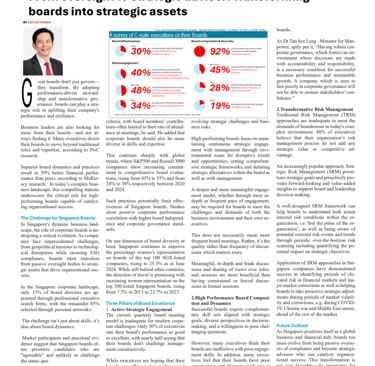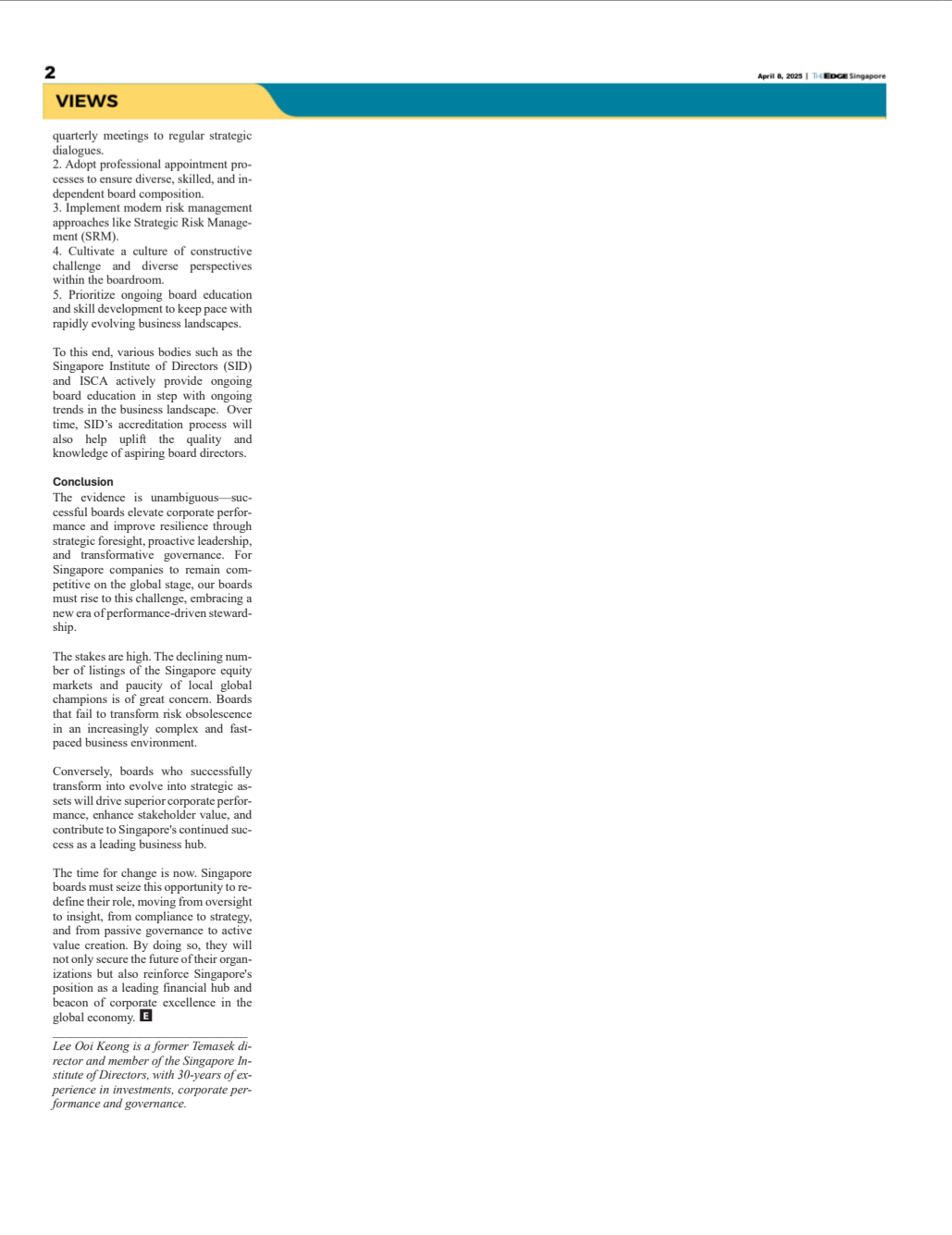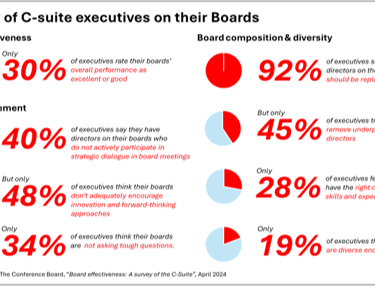From Oversight to Strategic Advisor: Transforming Boards into Strategic Assets
The Edge Singapore featured my article "From Oversight to Strategic Advisor: Transforming Boards into Strategic Assets" on 8 April 2025
Lee Ooi Keong
4/8/20255 min read




From Oversight to Strategic Advisor: Transforming Boards into Strategic Assets
Great boards don't just govern—they transform. By adopting performance-driven stewardship and transformative governance, boards can play a strategic role in uplifting their company's performance and resilience.
Business leaders are also looking for more from their boards—and not always finding it. Many executives desire their boards to move beyond traditional roles and expertise, according to PwC research[1].
Superior board dynamics and practices result in 59% better financial performance than peers, according to McKinsey research[2]. In today’s complex business landscape, this compelling statistic underscores the critical role for high-performing boards capable of catalyzing organizational success.
The Challenge for Singapore Boards
In Singapore's dynamic business landscape, the role of corporate boards is undergoing a critical evolution. As companies face unprecedented challenges, from geopolitical tensions to technological disruptions while ensuring ESG compliance, boards must transition from passive oversight bodies to strategic assets that drive organizational success.
In the Singapore corporate landscape, only 15% of board directors are appointed through professional executive search firms, with the remainder 85% selected through personal networks.
The challenge isn’t just about skills; it’s also about board dynamics.
Market participants and anecdotal evidence suggest that Singapore boards often prioritize candidates who are "agreeable" and unlikely to challenge the status quo.
Ravi Menon, the former Monetary Authority of Singapore (MAS) managing director noted[3], 50% of listed companies in Singapore are still providing boilerplate disclosures and are unwilling to disclose any objective performance criteria, with board members’ contributions often limited to their rate of attendance at meetings, he said. He added that corporate boards should also be more diverse in skills and expertise.
This contrasts sharply with global trends, where S&P500 and Russell 3000 companies show increasing commitment to comprehensive board evaluations, rising from 43% to 55% and from 24% to 38% respectively between 2020 and 2024.
Such practices potentially limit effectiveness of Singapore boards. Studies show positive corporate performance correlation with higher board independence and corporate governance standards.
On one dimension of board diversity at least, Singapore continues to improve the percentage women’s representation on boards of the top 100 SGX-listed companies, rising to 25.3% as at June 2024[4]. While still behind other countries, the direction of travel is promising with increasing women representation on the top 100-listed Singapore boards, rising from 7.5% in 2013 to 23.7% in 2023.
Three Pillars of Board Excellence
1. Active Strategic Engagement
The current quarterly board meeting model is inadequate for modern corporate challenges. Only 30% of executives rate their board's performance as good or excellent, with nearly half saying that their boards don't challenge management constructively.
While executives are hoping that their boards can offer greater guidance and leadership, 40% of executives report insufficient board participation in strategic dialogue, with many executives having little confidence in their board’s ability to pivot and adapt amid the fast-evolving strategic challenges and business risks.
High-performing boards focus on maintain continuous strategic engagement with management through environmental scans for disruptive trends and opportunities, setting comprehensive strategic frameworks, and debating strategic alternatives within the board as well as with management.
A deeper and more meaningful engagement model, whether through more in-depth or frequent pace of engagement, may be required for boards to meet the challenges and demands of both the business environment and their own executives.
This does not necessarily mean more frequent board meetings. Rather, it’s the quality rather than frequency of discussions which matters more.
Meaningful, in-depth and frank discussions and sharing of views over informal sessions are more beneficial than having constrained or forced discussions in formal sessions.
2. High Performance Board Composition and Dynamics
Successful boards require complementary skill sets aligned with strategic goals, diverse perspectives in decision-making, and a willingness to pose challenging questions.
However, many executives think their boards are ineffective with poor engagement skills. In addition, many executives feel that their boards have poor composition and diversity, with one or more board directors inadequate for the role, according to PwC.
There is clearly a desire from management executives and regulators for higher quality, effective and diverse boards.
As Dr Tan See Leng[5], Minister for Manpower, aptly put it,
“Having robust corporate governance, which fosters an environment where decisions are made with accountability and responsibility, is a necessary condition for successful business performance and sustainable growth. A company which is seen to fare poorly in corporate governance will not be able to sustain stakeholders' confidence."
3. Transformative Risk Management
Traditional Risk Management (TRM) approaches are inadequate to meet the demands of boardrooms in today's complex environment. 88% of executives believe that their organization’s risk management process do not add any strategic value or competitive advantage[6].
An increasingly popular approach, Strategic Risk Management (SRM) prioritizes strategic goals and pro-actively provides forward-looking and value-added insights to support board and leadership decision-making.
A well-designed SRM framework can help boards to understand both actual internal risk conditions within the organization, i.e. ‘feel the pulse of the organization’, as well as being aware of potential external risk events and trends through periodic over-the-horizon risk scanning including quantifying the potential impact on strategic objectives.
Application of SRM approaches in Singapore companies have demonstrated success in identifying periods of elevated risk in financial markets and major market corrections as well as helping boards to take proactive strategic adjustments during periods of market volatility and corrections, e.g. during COVID-19, Ukraine war and Middle East unrest, ahead of the rest of the market.
Future Outlook
As Singapore positions itself as a global business and financial hub, boards too must evolve from being passive overseers of compliance and become strategic advisors who can catalyze organizational success. This transformation is not just desirable—it's imperative for maintaining Singapore's competitive edge in the global marketplace.
To achieve this, Singapore boards must:
Embrace continuous engagement with management, moving beyond quarterly meetings to regular strategic dialogues.
Adopt professional appointment processes to ensure diverse, skilled, and independent board composition.
Implement modern risk management approaches like Strategic Risk Management (SRM).
Cultivate a culture of constructive challenge and diverse perspectives within the boardroom.
Prioritize ongoing board education and skill development to keep pace with rapidly evolving business landscapes.
To this end, various bodies such as the Singapore Institute of Directors (SID) and ISCA actively provide ongoing board education in step with ongoing trends in the business landscape. Over time, SID’s accreditation process will also help uplift the quality and knowledge of aspiring board directors.
Conclusion
The evidence is unambiguous—successful boards elevate corporate performance and improve resilience through strategic foresight, proactive leadership, and transformative governance. For Singapore companies to remain competitive on the global stage, our boards must rise to this challenge, embracing a new era of performance-driven stewardship.
The stakes are high. The declining number of listings of the Singapore equity markets and paucity of local global champions is of great concern. Boards that fail to transform risk obsolescence in an increasingly complex and fast-paced business environment.
Conversely, boards who successfully transform into evolve into strategic assets will drive superior corporate performance, enhance stakeholder value, and contribute to Singapore's continued success as a leading business hub.
The time for change is now. Singapore boards must seize this opportunity to redefine their role, moving from oversight to insight, from compliance to strategy, and from passive governance to active value creation. By doing so, they will not only secure the future of their organizations but also reinforce Singapore's position as a leading financial hub and beacon of corporate excellence in the global economy.
Written by:
Lee Ooi Keong, MSID
28 January 2025
+65 9787 6888 (Whatsapp)
ooikeong@yahoo.com
Brief bio:Ooi Keong is a former Temasek director and member of the Singapore Institute of Directors, with 30-years of experience in investments, corporate performance and governance.
[1] PwC and The Conference Board, “Board effectiveness: A survey of the C-Suite”, April 2024
[2] McKinsey & Company, “A time for boards to act”, March 2018
[3] The Straits Times, “S’pore firms can do more to improve corporate governance and build trust: MAS chief Ravi Menon”, November 2024
[4] Council for Board Diversity, https://www.councilforboarddiversity.sg
[5] Dr Tan See Leng, Minister for Manpower, MAS-IBF "Growing Timber" Webinar Series, September 2021
[6] AICPA and CIMA, Pool College of Management, “The State of Risk Oversight, 2024”,



